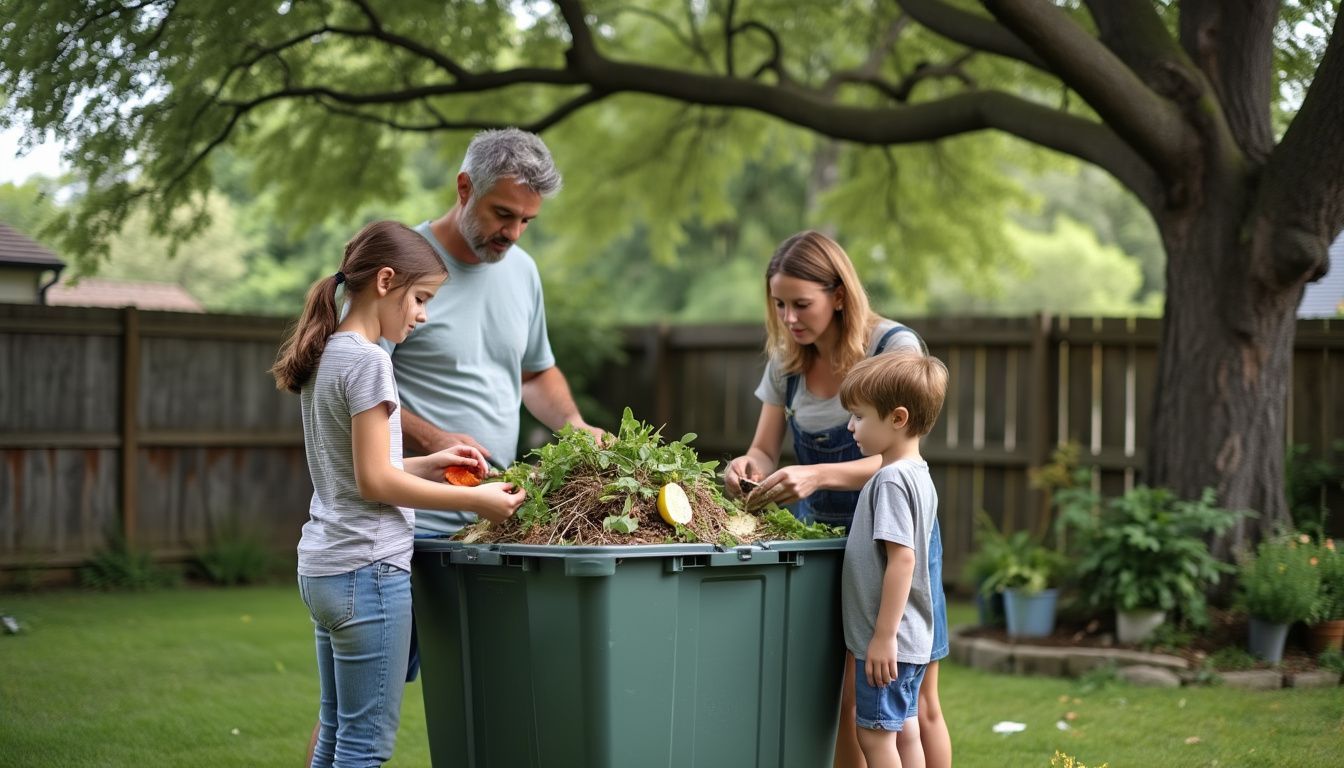Managing waste can be confusing. Many people aren’t sure how to sort their rubbish properly. This confusion can lead to more waste in landfills and harm the environment. Understanding the **4 Types Of Waste Segregation** is essential for effective waste management. 2
Did you know that separating waste can significantly reduce greenhouse gas emissions? 1 This article breaks down the four main types: organic waste, recyclable materials, non-recyclable waste, and hazardous waste.
You’ll learn practical tips to sort your waste correctly and support a sustainable future. Start making a positive impact today. 3
Key Takeaways
- Four Waste Types: Waste is sorted into organic, recyclable, non-recyclable, and hazardous categories.
- Environmental Benefits: Separating waste reduces landfill use and lowers greenhouse gas emissions.
- Composting Organic Waste: Turns food scraps and garden waste into soil-friendly compost.
- Recycling Materials: Properly sorting paper, plastic, metal, and glass conserves resources and boosts recycling rates.
- Safe Disposal: Non-recyclable and hazardous waste must be handled carefully to protect the environment and health.
Organic Waste

Organic waste includes food scraps, garden waste, and other biodegradable materials. Composting this waste reduces landfill use and creates rich compost for gardens.

Composting Benefits and Techniques
Composting cuts down food waste and reduces landfill use. It supports eco-friendly waste management.
- Reduces Landfill Waste: Composting transforms food scraps and garden waste into useful compost, minimising garbage in dumps. 1
- Improves Soil Quality: Finished compost enhances soil with recycled materials, boosting plant growth and supporting agriculture.
- Supports Circular Economy: Reusing organic waste helps conserve resources and promotes sustainable waste management practices.
- Various Composting Techniques:
- Cold Composting: Simple method with minimal upkeep, ideal for large amounts of waste.
- Hot Composting: Speeds up decomposition, producing compost quickly and killing harmful pathogens. 1
- Tumbler Composting: Uses a rotating bin for easy mixing, ensuring even breakdown of materials.
- Worm Composting: Utilises worms to efficiently break down organic waste into rich compost.
- Bokashi Composting: Ferments waste with special microbes, handling a wider range of organic materials.
- Balanced Compost Bin: Maintain two-thirds wet materials like food scraps and one-third dry materials such as leaves and paper to ensure effective decomposition.
- Year-Round Composting: With proper management, composting can be done throughout the year, provided there is a steady supply of organic waste.
- Mature Compost Indicators: Dark, crumbly texture and earthy smell show that compost is ready to use in gardens or for resource recovery.
- Nitrogen to Carbon Ratio: Keeping the right balance of nitrogen and carbon is crucial for efficient composting and to prevent pollutants from forming.
- Environmental Benefits: Composting reduces methane gas from landfills, decreases air pollution, and lowers the need for chemical fertilisers.
- Energy Sustainability: Producing compost requires less energy compared to manufacturing synthetic fertilisers, supporting sustainable energy goals.
Recyclable Materials
Properly sorting paper, plastic, metal, and glass at recycling centres ensures these materials are reused, conserving resources and reducing landfill waste—discover the best methods below.

Methods for Paper, Plastic, Metal, and Glass Separation
Separate collection of paper, plastic, metal, and glass is essential for effective recycling. These methods enhance the preparation for reuse and recovery. 3
- Paper Separation
- Collect newspapers, magazines, and cardboard separately.
- Use bins labelled for paper to avoid contamination.
- Ensure paper is clean and dry before collection.
- Paper recycling reduces waste in landfills and saves trees.
- Plastic Separation
- Sort plastics into categories: PET, HDPE, PVC, LDPE, PP, and others.
- Remove lids and caps as they may be made of different plastics.
- Rinse plastics to remove food residue.
- Label containers clearly to aid recycling facilities.
- Metal Separation
- Separate ferrous metals (like steel) from non-ferrous metals (like aluminium).
- Use magnets to identify and sort ferrous metals.
- Compress metals to save space during transport.
- Metals can be recycled repeatedly without losing quality.
- Glass Separation
- Sort glass by colour: clear, green, and brown.
- Remove any non-glass materials such as caps or lids.
- Clean glass to prevent contamination.
- Glass recycling conserves raw materials and reduces energy use.
Compliance with the Environmental Permitting Regulations ensures that separately collected waste is not sent to landfill or incineration. 2 These separation methods maximise the quantity and quality of recyclables.
Non-Recyclable Waste
Non-recyclable waste cannot be reused or recycled. We must dispose of it safely using landfills or incineration to protect the environment.

Handling and Disposal Options
Non-recyclable waste requires careful handling to minimise environmental impact. Various disposal methods ensure that harmful materials are managed safely.
- Landfill Disposal
Landfills are the most common method for disposing of non-recyclable waste in the UK. They store waste in large sites, but this can lead to soil and water pollution. Modern landfills use liners and leachate management to reduce environmental harm. However, landfilling still occupies valuable land and produces greenhouse gases as waste decomposes. 4 - Incineration
Incineration burns non-recyclable waste, significantly reducing its volume by up to 90%. This process generates energy, contributing to waste-to-energy programmes. Despite its benefits, incineration can release toxic pollutants like dioxins if not properly managed. Advanced filters and scrubbers are essential to minimise emissions and protect air quality. 4 - Waste-to-Energy
Waste-to-energy facilities convert non-recyclable waste into electricity or heat. This method helps decrease reliance on fossil fuels and reduces the amount of waste sent to landfills. Biogas from anaerobic digestion can also be used as a renewable energy source. Efficient technology ensures that energy recovery is maximised while environmental standards are met. - Safe Disposal of Hazardous Materials
Medical waste and other hazardous materials require specialised disposal methods to prevent contamination. Incinerators with high-temperature chambers safely eliminate these wastes. Alternatively, chemical treatment or secure landfilling can be used for toxic substances. Strict regulations ensure that hazardous waste is handled without harming public health or the environment. - Construction and Demolition Waste Management
Debris from construction sites, such as concrete and wood, must be managed to reduce environmental impact. Recycling facilities process these materials, but some non-recyclable parts are disposed of in landfills. Implementing proper segregation on-site can enhance recycling rates and decrease overall waste generation.
The Drycake Twister Depackager and Separator: An Example of Recent Advances in Segregation Techology
The Drycake Twister Depackager and Separator enhances waste segregation in the UK. It sorts solid waste efficiently, separating paper, plastic, metal, and glass. 5 This reduces cross-contamination and improves recycling rates.
By minimising waste sent to landfills, the Twister supports environmentally friendly waste disposal. Businesses can meet new government regulations on waste separation with this advanced technology.
Integrating the Drycake Twister into waste management systems boosts efficiency and sustainability. It aligns with the waste hierarchy by prioritising recycling over disposal. The technology recovers valuable resources from municipal solid waste, decreasing environmental impact.
Waste management professionals and government officials benefit from its ability to streamline segregation processes, fostering more sustainable practices.
The Drycake Twister sets a benchmark for efficient waste segregation, driving sustainability forward.
Conclusion and Best Practices for Waste Segregation
Proper waste segregation helps the environment and public health. Sort waste into organic, recyclable, non-recyclable, and hazardous types. Compost food and yard waste. Recycle paper, plastic, metal, and glass.
Handle e-waste carefully and avoid placing it in bins provided for other waste types. Follow these steps to minimise pollution and conserve resources.
FAQs
1. What are the four types of waste segregation in the UK?
In the UK, waste separation includes household waste, food waste, yard waste, and hazardous waste or e-waste. Each type is sorted to reduce environmental impacts and promote recycling.
2. How does a food waste separator help with waste segregation?
A food waste separator splits wet waste from dry. This helps maintain hygiene and allows compost piles to produce digestate, which can be reused in gardens.
3. What is e-waste and how should it be handled?
E-waste, or electronic waste, includes old phones and computers. It should be taken to material recycling facilities or scrap dealers to recover valuable resources and prevent pollution.
4. Why is separating sewage sludge important?
Separating sewage sludge in wastewater treatment facilities creates biosolids and treated wastewater. This process helps reduce environmental contamination and supports a closed-loop system.
5. How does waste segregation impact the environment?
Proper segregation helps recover resources, reduce polluting waste incineration, and lower environmental contamination. It also supports reusable materials and lessens overall environmental impacts.
6. What is extended producer responsibility in waste segregation?
Extended producer responsibility means producers are responsible for their waste products. This encourages them to create reusable materials and ensures proper waste segregation, enhancing workplace health and safety.
References
- ^ https://cpdonline.co.uk/knowledge-base/food-hygiene/composting-waste/ (2022-02-25)
- ^ https://www.gov.uk/guidance/separate-collection-of-waste-paper-plastic-metal-and-glass
- ^ https://www.netregs.org.uk/environmental-topics/waste/reduce-reuse-and-recycle-your-business-waste/separating-and-storing-waste/
- ^ https://affordablewastemanagement.co.uk/4-types-of-waste-management/ (2023-04-11)
- ^ https://wastersblog.com/101429/food-waste-depackaging-methods/ (2022-03-26)






